The AMD Radeon VII Review: An Unexpected Shot At The High-End
by Nate Oh on February 7, 2019 9:00 AM ESTVega 20 Under The Hood: GCN on 7nm
Though we’ve known of Vega 20 for some time with the launch of server-class Radeon Instinct MI50 and MI60, its arrival to the consumer space does mark the first 7nm gaming card. Rapidly moving down to a lower node – this time from GlobalFoundries 14nm LPP to TSMC 7nm (CLN7FF) – used to be an AMD/ATi hallmark, and once again AMD is pushing the envelope by bringing it so early to consumers. That being the case, all the attributes of Vega 20 look squarely to be for the professional/server crowd, though not devoid of benefits for gaming.
Of the many threads in the Radeon VII story, the fate of Vega as a whole has been nothing short of enigmatic. To start things off, the 7nm Vega 20 GPU making its way to consumers was a surprise to most, at least arriving this early. And while AMD only made mention of Vega 20 in reference to Radeon Instinct products – referring to the forthcoming Navi when speaking about 7nm GPUs for gamers – AMD now maintains that the plan was always to bring Radeon VII to market. Perhaps the same might have been said regarding Vega on 14nm+/12LP and the Vega 11 GPU (not to be confused with Ryzen 2400G’s 11 Vega compute units), though to be clear this is hardly unusual given the nature of semiconductor development.
To be fair, AMD has only been coy at best about Vega since the RX Vega launch, which didn’t quite land where AMD wanted it to. But even as a bit of Schrodinger’s silicon, the existence of Radeon VII does raise some interesting questions about 7nm. For one, AMD had already moved up their Vega 20 sampling and launch windows previously. So Radeon VII’s launch timing is realistically the earliest it could be for a consumer derivative of the Radeon Instinct. Even more so is that with a die size of 331mm2, these aren’t small mobile SoCs or comparable ‘pipecleaner’ silicon that we’ve seen so far on TSMC 7nm. Designed with compute/ML-oriented enhancements, equipped with 4 HBM2 stacks, and fabbed on a maturing and cutting-edge 7nm node, Vega 20 has nothing on paper to push for its viability at consumer prices. And yet thanks to a fortunate confluence of factors, here we are.
At a high level. Vega 20 combines an updated GCN 5 architecture with a 7nm process, coming out to 13.2B transistors on 331mm2 (versus 12.5B transistors on 496mm2 for Vega 10). Typically with die shrinks, these space-savings are often reinvested into more transistors – for a gaming card, that can mean anything from more CUs and functional blocks, to layout redesigns and hardened data paths for improved frequency tolerance. The latter, of course, is to enable higher clockspeeds, and this design choice was a big part of Vega 10, where a significant number of transistors were invested to meeting the requisite timing targets. In conjunction with power-savings of a smaller node, a chip can then get to those higher clocks without additional power.
For Vega 20 however, much of the saved space was left simply as that: more space. There’s several reasons of this, some obvious, and some less so. To start things off, as a relatively large high-performance GPU on a leading-edge 7nm node early in its life, development and production is already costly and likely lower-yielding, where going any larger would cost substantially more and yield less. And though TSMC’s 7nm process has only publicly been seen in mobile SoCs thus far, Vega 20 presumably makes good use of the HPC-oriented 7.5T libraries as needed, as opposed to using the 6T libraries intended for mobile SoCs.
But more importantly, the saved space allows room for two more stacks of HBM2 on a similarly-sized interposer. For current-generation HBM2 densities and capabilities, the limit for a two stack chip is 16GB of memory, using a pair of "8-Hi" stacks. But for a server-grade GPU – especially one targeting machine learning – a four stack configuration needed to happen in order to allow for 32GB of memory and a wider 4096-bit bus. For Vega 20, AMD has delivered on just this, and furthermore is producing both 32GB (8-Hi) and 16GB (4-Hi) versions of the chip.
Radeon VII, in turn, is tapping one of these 16GB chips for its core design. It should be noted that this isn't AMD's first 16GB Vega card – they also produced one early on with their early-adopted focused Vega Frontier Edition card – but since the Frontier Edition's retirement, this is the first (re)introduction of a 16GB card to AMD's Vega lineup.
Going with a 16GB for a consumer(ish) card is a bit of a gamble for AMD. And, I suspect, this is part of the reason we're also seeing AMD chase part of the professional visualization market with the Radeon VII. When it comes to workstation use and content creation tasks, more VRAM is an easy sell, as there are already datasets that can use all of that VRAM and more. But for gaming this is a harder sell, as games have more fixed VRAM requirements, and absent such a large card until now, developers haven't yet started targeting 16GB cards. On the flip side, however, the statement "this card has more than enough VRAM" has proven to be famous last words, and in 2019 a flagship enthusiast-grade gaming card ought to have that much anyway.
Getting back to Vega 20's design then, the other step AMD has taken to reduce the complications and cost of 7nm is by sticking to a die-shrink of a known architecture. Here AMD has added optimizations over Vega 10, but they did not risk a large redesign. Basically it's the logic behind the ‘tick’ of Intel’s old ‘tick-tock’ strategy.
In fact Vega 20 is such a straightforward shrink of Vega 10 in this manner that, outside of the number of memory controllers, all of the other functional unit counts at the same. The GPU packs 64 CUs and 256 texture units segmented into 4 Shader Engines, which in turn are paired with 64 ROPs and AMD's multi-queue command processor.
(I should add that by going this route, AMD also neatly sidesteps the question of shader engine scaling. The nature of that 4 SE limitation has been left vague in recent years, but with Vega there were hints of a path beyond with improved load-balancing via the intelligent workgroup distributors (IWD). Regardless, it would be a complex task in itself to tweak and redesign a balanced 4+ SE configuration, which might be unnecessary effort if AMD has fundamental changes to GCN in the pipeline.)
So on an architectural level, Vega 20 is very much an evolutionary design. But with that said, there is a bit more evolution to it than just the die-shrink, the combination of which means that Vega 20 should in practice be a bit faster than Vega 10 on a clock-for-clock basis.
The big improvement here is all of that extra memory bandwidth; there's now over twice as much bandwidth per ROP, texture unit, and ALU as there was on Vega 10. The bodes particularly well for the ROPs, which have traditionally always been big bandwidth consumers. Not stopping there, AMD has also made some improvements to the Core Fabric, which is what connects the memory to the ROPs (among other things). Unfortunately AMD isn't willing to divulge just what these improvements are, but they have confirmed that there aren't any cache changes among them.
Another piece of the puzzle is that AMD has added some new instructions and data types that will speed up machine learning in certain cases. AMD hasn't given us the complete details here, but at a high level we know that they've added support for INT8 and INT4 data types, which are useful for some low-precision inference scenarios. AMD has also added a new FP16 dot product that accumulates as an FP32 result, a rather specific scenario that is helpful for some machine learning algorithms, as it produces a higher precision result than a FP16-in/FP16-out dot product.
Speaking of data types, AMD has also significantly ramped up their FP64 performance for Vega 20. As a core architecture, GCN allows a GPU to be built with a rate ranging from 1/2 to 1/16 the FP32 rate. For pure consumer GPUs this has always been 1/16, however for GPUs that have pulled double-duty as server-focused chips, they have enabled 1/4 and 1/2 rates in the past. Vega 20, in turn, is the first 1/2 rate FP64 GPU from AMD since Hawaii in 2013. This means that while its general FP32 performance gains over Vega 10 cards are somewhat limited, its FP64 gains are nothing short of massive – better than 8x over the RX Vega 64, on paper. Of course as a consumer card the Radeon VII doesn't quite get to enjoy these benefits – it's limited to 1/4 rate – but more on that later.
Meanwhile, for AMD's video and display controller blocks, there have only been minor, incremental updates. Officially, the display controller (DCE) is up to version 12.1, while we're on unified video decoder (UVD) 7.2, and video coding engine (VCE) 4.1. No additional encoding or decoding feature support have been added compared to Vega 10. For what it’s worth, we’ve already seen the successor blocks with Raven Ridge’s Display Core Next and Video Core Next 1.0, so this may be the last architecture that those ASICs grace us with their presence.
Wrapping up the functional blocks is a new style of SMU, discussed in recent Linux kernel patches. Orthogonal, but closely related, is improved thermal monitoring, where the number of temperature diodes has been doubled to 64 sensors. As a consequence, AMD is now fully utilizing junction temperature monitoring instead of edge temperature monitoring. Junction temperature measurements were used in Vega 10 (showing up as ‘hotspot’ temperature) but Vega 20 has made the full jump to junction temperature for the full suite of fanspeeds, clockspeeds, and such. The result is more accurate reporting, as well as minor 1-2% performance gains (via reduced throttling) that AMD cites from internal testing.
The updated SMU also brings with it a knock-on effect: temperature, clockspeed, and related GPU metrics are no longer read through registers, but instead grabbed straight from the SMU. Naturally, this breaks compatibility with third-party utilities (i.e. GPU-Z), and while AMD has already notified some developers of these changes, applications will still need to be updated to use AMD's new API calls.
Finally, as this is AMD's first new high-end Vega silicon since the original Vega 10 in 2017, there have been a few questions swirling around Vega’s forward-looking hardware features. AMD's communication hasn't always been clear here, and as a result these features have become sort of a perpetual source of consumer confusion.
To settle matters for Vega 20 then, AMD doesn’t seem to be changing the situation here. Which is to say that there have been no further developments as far as AMD's primitive shaders are concerned. Primitive shaders will still require explicit developer support – something AMD has not enabled – and so the full capabilities of Vega 20's Next-Gen Geometry path aren't being utilized (though we should note that the Intelligent Workgroup Distributor portion has always been enabled).
Meanwhile, AMD's Draw Stream Binning Rasterizer (DSBR) was already up and working in Vega 10, so this hasn't changed; the feature is enabled for an unspecified list of games. And checking in quickly on Rapid Packed Math (fast FP16), this is in use for two known games: Far Cry 5 and Wolfenstein II.


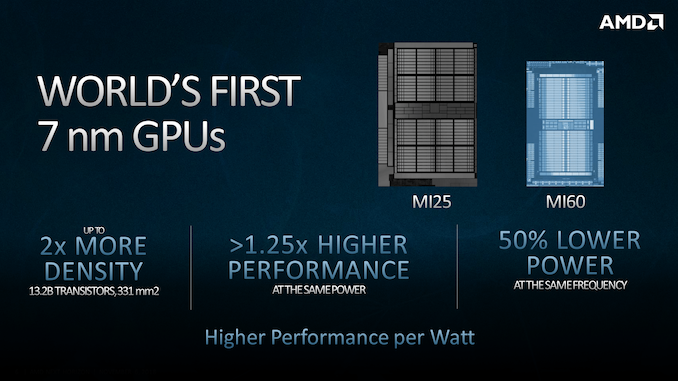
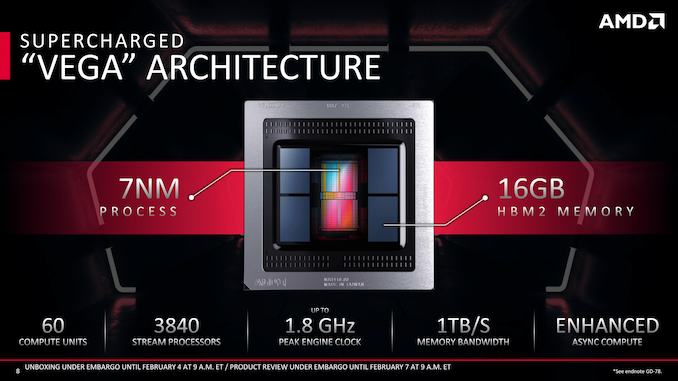

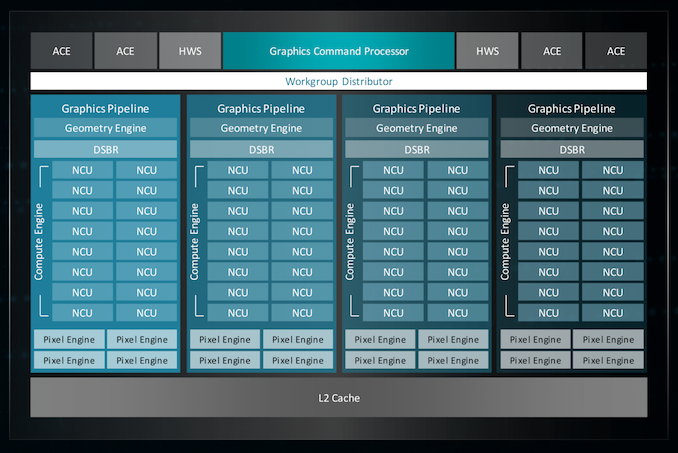

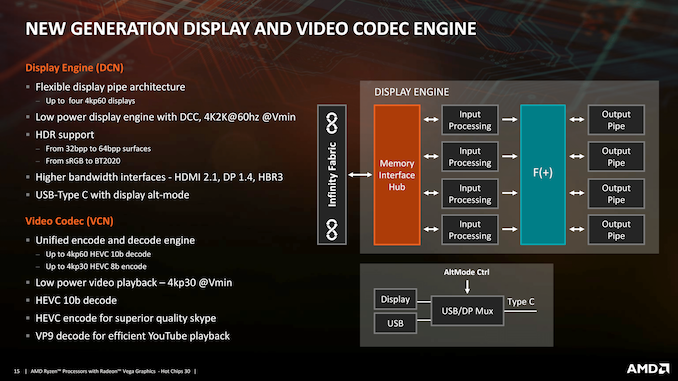
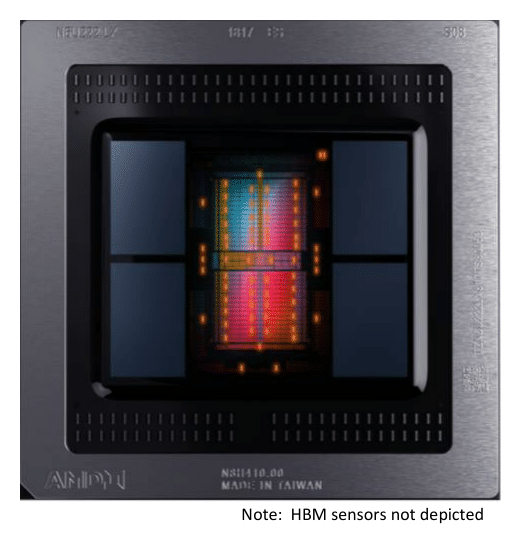








289 Comments
View All Comments
schizoide - Thursday, February 7, 2019 - link
Sure it does, at the bottom-end. It basically IS an instinct mi50 on the cheap.GreenReaper - Thursday, February 7, 2019 - link
Maybe they weren't selling so well so they decided to repurpose before Navi comes out and makes it largely redundant.schizoide - Thursday, February 7, 2019 - link
IMO, what happened is pretty simple. Nvidia's extremely high prices allowed AMD to compete with a workstation-class card. So they took a swing.eva02langley - Friday, February 8, 2019 - link
My take to. This card was never intended to be released. It just happened because the RTX 2080 is at 700+$.In Canada, the RVII is 40$ less than the cheapest 2080 RTX, making it the better deal.
Manch - Thursday, February 7, 2019 - link
It is but its slightly gimped perf wise to justify the price diff.sing_electric - Thursday, February 7, 2019 - link
Anyone else think that the Mac Pro is lurking behind the Radeon VII release? Apple traditionally does a March 2019 event where they launch new products, so the timing fits (especially since there's little reason to think the Pro would need to be launched in time for the Q4 holiday season).-If Navi is "gamer-focused" as Su has hinted, that may well mean GDDR6 (and rays?), so wouldn't be of much/any benefit to a "pro" workload
-This way Apple can release the Pro with the GPU as a known quantity (though it may well come in a "Pro" variant w/say, ECC and other features enabled)
-Maybe the timing was moved up, and separated from the Apple launch, in part to "strike back" at the 2080 and insert AMD into the GPU conversation more for 2019.
The timeline and available facts seem to fit pretty well here...
tipoo - Thursday, February 7, 2019 - link
I was thinking a better binned die like VII for the iMac Pro.Tbh the Mac Pro really needs to support CUDA/Nvidia if it's going to be a serious contendor for scientific compute.
sing_electric - Thursday, February 7, 2019 - link
I mean, sure? but I'm not sure WHAT market Apple is going after with the Mac Pro anyways... I mean, would YOU switch platforms (since anyone who seriously needs the performance necessary to justify the price tag in a compute-heavy workload has almost certainly moved on from their 2013 Mac Pro) with the risk that Apple might leave the Pro to languish again?There's certainly A market for it, I'm just not sure what the market is.
repoman27 - Thursday, February 7, 2019 - link
The Radeon VII does seem to be one piece of the puzzle, as far as the new Mac Pro goes. On the CPU side Apple still needs to wait for Cascade Lake Xeon W if they want to do anything more than release a modular iMac Pro though. I can't imagine Apple will ever release another dual-socket Mac, and I'd be very surprised if they switched to AMD Threadripper at this point. But even still, they would need XCC based Xeon W chips to beat the iMac Pro in terms of core count. Intel did release just such a thing with the Xeon W 3175X, but I'm seriously hoping for Cascade Lake over Skylake Refresh for the new Mac Pro. That would push the release timeline out to Q3 or Q4 though.The Radeon VII also appears to lack DisplayPort DSC, which means single cable 8K external displays would be a no-go. A new Mac Pro that could only support Thunderbolt 3 displays up to 5120 x 2880, 10 bits per color, at 60 Hz would almost seem like a bit of a letdown at this point. Apple is in a bit of an awkward position here anyway, as ICL-U will have integrated Thunderbolt 3 and an iGPU that supports DP 1.4a with HBR 3 and DSC when it arrives, also around the Q3 2019 timeframe. I'm not sure Intel even has any plans for discrete Thunderbolt controllers after Titan Ridge, but with no PCIe 4.0 on Cascade Lake, there's not much they can even do to improve on it anyway.
So maybe the new Mac Pro is a Q4 2019 product and will have Cascade Lake Xeon W and a more pro-oriented yet Navi-based GPU?
sing_electric - Thursday, February 7, 2019 - link
Possibly, but I'm not 100% sure that they need to be at the iMac Pro on core count to have a product. More RAM (with a lot of slots that a user can get to) and a socketed CPU with better thermals than you can get on the back of a display might do it. I'd tend to think that moving to Threadripper (or EPYC) is a pipe dream, partly because of Thunderbolt support (which I guess, now that it's open, Apple could THEORETICALLY add, but it just seems unlikely at this point, particularly since there'd be things where a Intel-based iMac Pro might beat a TR-based Mac Pro, and Apple doesn't generally like complexities like that).Also, I'd assumed that stuff like DSC support would be one of the changes between the consumer and Pro versions (and AMD's Radeon Pro WX 7100 already does DSC, so its not like they don't have the ability to add it to pro GPUs).